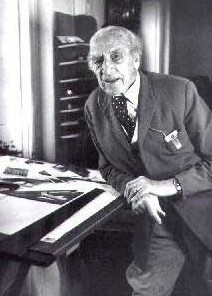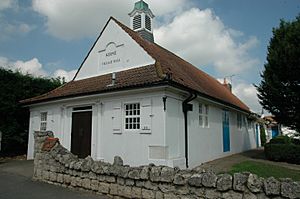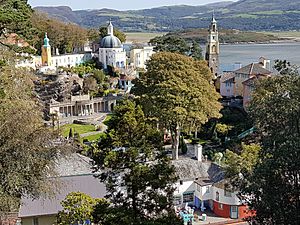Clough Williams-Ellis facts for kids
Quick facts for kids
Sir Clough Williams-Ellis
|
|
|---|---|
 |
|
| Born | 28 May 1883 Gayton, Northamptonshire, England
|
| Died | 9 April 1978 (aged 94) |
| Occupation | Architect |
| Projects | Creator of the Italianate village of Portmeirion in North Wales |
Sir Bertram Clough Williams-Ellis (born May 28, 1883 – died April 9, 1978) was a famous Welsh architect. He is best known for creating the unique Italian-style village of Portmeirion in North Wales. He played a big part in shaping Welsh architecture during the first half of the 1900s, working in many different styles and building types.
Contents
Early Life and Education
Clough Williams-Ellis was born in Gayton, Northamptonshire, England. However, his family moved to North Wales, where his father was from, when Clough was just four years old. His family had strong Welsh roots. Clough Williams-Ellis even said he was a direct descendant of Owain Gwynedd, a Prince of North Wales. His father was a clergyman and a well-known mountaineer.
He went to Oundle School in Northamptonshire. Later, he studied natural sciences at Trinity College, Cambridge, but he didn't finish his degree. In 1903, he spent a few months at the Architectural Association School of Architecture in London. After that, he worked for another architect for a short time before starting his own architecture business in London.
One of his first projects was a summer house called Larkbeare in Oxfordshire, which he designed while still a student. In 1908, he inherited a small country house called Plas Brondanw. He spent the rest of his life restoring and improving this house, even rebuilding it after a fire in 1951.
Serving His Country
Williams-Ellis bravely served in the First World War. He first joined the Royal Fusiliers and then the Welsh Guards. He worked as an intelligence officer with the Tank Corps.
Designing Buildings and Places
After the war, Williams-Ellis helped bring back an old building method called pisé (rammed earth) in Britain. He built an apple storage house and a bungalow using this technique.
Some of his early designs included Welsh cottages that looked like traditional 16th-century homes. In 1913–1914, he rebuilt Llangoed Hall in Breconshire. This was one of the last large country houses built before the First World War. It mixed old styles with modern features. Other buildings he designed in Wales include the Festiniog Memorial Hospital (1922), Pentrefelin Village Hall, and the Conway Fall Cafe.
Portmeirion: A Dream Village
In 1925, Williams-Ellis bought land in North Wales. This land became the famous Italian-style village of Portmeirion. This village later became well-known as the filming location for the TV series The Prisoner and a Doctor Who story. Portmeirion is special because Williams-Ellis saved parts from other old buildings that were being torn down. He used these pieces in his new village, like a plaster ceiling from Emral Hall.
Saving the Countryside
In 1928, Williams-Ellis wrote a book called England and the Octopus. In this book, he spoke out against the way cities were growing and taking over the countryside. His book inspired a group of young women to form a group called Ferguson's Gang. From 1927 to 1946, they worked to save important old buildings and land from being destroyed.
Thanks to their efforts, places like Shalford Mill in Surrey and Newtown Old Town Hall on the Isle of Wight were saved. The Gang raised money and gave these properties to the National Trust to protect them. Peggy Pollard, one of the Gang's leaders, became a lifelong friend of Williams-Ellis.
By the 1930s, Williams-Ellis was a very popular architect in Britain. He designed many buildings across the UK. These included buildings at Stowe, Buckinghamshire, cottages in Cornwell, Oxfordshire, and buildings in Cushendun, County Antrim, Northern Ireland.
He also designed the old summit building on Snowdon, Wales' highest mountain. However, this building was later changed many times and was eventually described as "the highest slum in Wales" by Prince Charles. It was torn down in 2007.
Williams-Ellis also worked on government groups focused on design and protecting nature. He helped set up the British national parks after 1945. He wrote and spoke a lot about architecture and saving the countryside.
Later Works and Honors
In 1950, he designed the Old Post Office in Aberdaron in a traditional style. He also redesigned and rebuilt Nantclwyd Hall in Denbighshire. Williams-Ellis was also good at designing in the modern style of the 1920s and 30s. An example is the recently restored Caffi Moranedd at Cricieth.
In 1958, Williams-Ellis was given the honor of Commander of the Order of the British Empire (CBE) for his public service. In 1972, he was made a Knight Bachelor for his work in protecting the environment and architecture. At that time, he was the oldest person ever to be knighted.
Family Life
In 1915, Williams-Ellis married the writer Amabel Strachey. Their oldest daughter, Susan Williams-Ellis (1918–2007), started the famous Portmeirion Pottery company with her husband in 1961. Their second daughter, Charlotte, became a zoologist and environmentalist. Their youngest child, Christopher, was killed in action during the Second World War.
His grandson, Robin Llywelyn, is a Welsh novelist. His great-granddaughter is fashion designer Rose Fulbright-Vickers.
Death and Legacy
Sir Clough Williams-Ellis passed away in April 1978, at the age of 94. As he wished, he was cremated. Twenty years after his death, some of his ashes were put into a marine rocket. This rocket was launched as part of a New Year's Eve firework display over the estuary at Portmeirion.
Writings
Clough Williams-Ellis wrote many books and articles about architecture, design, and protecting the environment. Some of his notable works include:
- England and the Octopus (1928) - his famous book about protecting the countryside.
- The Adventure of Building (1946) - a book about architecture and planning for young people.
- Portmeirion, The Place and its Meaning (1963) - about his most famous creation.
- Architect Errant: The Autobiography of Clough Williams Ellis (1971) - his own life story.
He also co-wrote books with others, including his wife Amabel, such as The Pleasures of Architecture (1924).
Images for kids






